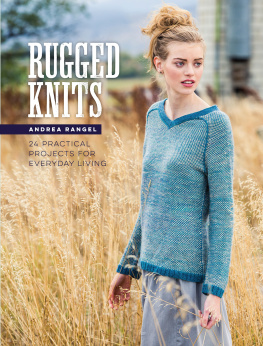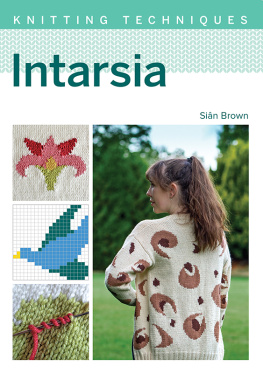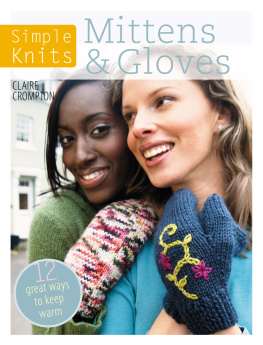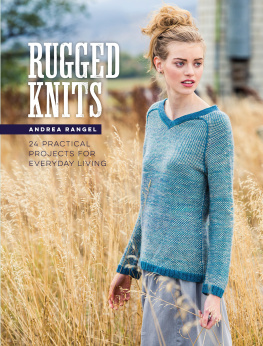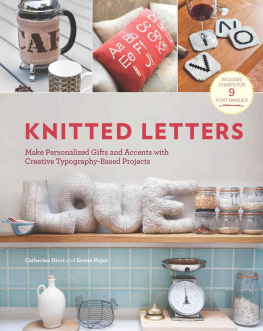Picture Perfect Knits

PICTURE PERFECT KNITS
Step-by-Step Intarsia with More than 75 Inspiring Patterns
By Laura Birek
--------------------------
Photographs by Sheri Giblin
Illustrations by Randy Stratton

I owe sincerest thanks to my editor, Jodi Warshaw, for all her guidance and help in the process of writing this book. I am also endlessly grateful to Cat Head, Madelyn Cain, my brother and parents, and all my friends who supported me in my knitting and writing.
Text copyright 2008 by Laura Birek.
Photographs copyright 2008 by Sheri Giblin.
Illustrations copyright 2008 by Randy Stratton.
All rights reserved. No part of this book may be reproduced in any form without written permission from the publisher.
Chronicle Books LLC
680 Second Street
San Francisco, California 94107
www.chroniclebooks.com
Library of Congress Cataloging-in-Publication Data is available
Birek, Laura.
Picture perfect knits / by Laura Birek ;
photographs by Sheri Giblin ;
illustrations by Randy Stratton.
Includes index.
ISBN: 978-0-8118-7215-7
CONTENTS

1 INTRODUCTION TO INTARSIA
INTRODUCTION
JUST WHAT THE HECK IS INTARSIA?
Just what the heck is intarsia? In a nutshell, intarsia is a style of knitting in which you work different colored shapes or designs into a knitted piece. Its easy. It looks cool. Its totally worth your while. Best of all, you can incorporate intarsia into almost any knitting pattern.
If youre a little dubious, I dont blame you. Few knitting techniques are as universally shrouded in darkness as intarsia is. Some knitting how-to books give the technique short shrift and many pattern books ignore intarsia completely.
There are many knitters who, though they enjoy intarsia, cant find a good pattern to save their lives. Ill admit it here and now: Many intarsia patterns are kitschy and dated, and they cant even be worn for ironic value. But it need not be so! You can just as easily knit a skull and crossbones with intarsia as you can a prancing reindeer. Its just a matter of finding (or creating) pretty and cool patternsexactly what I aim to provide for you right here in this book.
Picture Perfect Knits will show you that intarsia can be easy and beautiful. All it takes are a few simple skills, a bit of creativity, and a willingness to throw your preconceived notions out the window.
In the first section of the book I explain the basics of the technique and show you how to navigate intarsia charts and create your own patterns. Next, youll find 10 step-by-step patternsfrom an adorable dog sweater to a statement-making Che Guevara pillow. Included at back are over 50 intarsia design charts that you can use for a wide range of projects.
A BRIEF HISTORY OF INTARSIA
Before prancing reindeer and snowmen gave intarsia a bad name, argyle was the reigning king of the techniquethe noble grandfather of all intarsia work, if you will. It showed up on the scene in the 1500s, when members of the Campbell clan of Argyll, Scotland, rocked the motif on kilts and, later, footwear. The author Sir Walter Scott had a tendency to name-drop the Argyle boys in his novels, and soon the distinctive diamond pattern became known as argyle plaid.
In the 1940s, American women knit argyle socks en masse to send to their boys fighting overseas. Even after the GIs returned from duty, the style remained popular. And no design defined the preppy 1950s like a smart argyle vest.
Exactly when knitters took the leap from snappy argyle to what we now consider intarsia is unclear. Looking through old knitting books and magazines, youll find a variety of intarsia stylesplaids and geometrics as well as representational motifs from the 1960s and 1970s. The 1980s was a pretty popular decade for intarsialots of animal, floral, and allover abstract patterns, usually in bold colors. More recently, consider the work of Kaffe Fassett, one of the best-known knit designers. His designs feature rich colors and geometric and floral motifsa very contemporary use of intarsia.
ISNT IT MORE TROUBLE THAN ITS WORTH?
For some reason, intarsia strikes fear into the heart of even the most seasoned knitter. The main worry is how to deal with those separate strands of yarn dangling behind your piece. I grant that the wrong side of an intarsia swatch can look a little intimidating. But you will be fine as long as you stick with the techniques described in this book. Also, because you drop the old strand when you come to a color change, you only hold one color at a time, so theres no tricky double stranding, as in Fair Isle.
FAIR ISLE OR INTARSIA? WHATS THE DIFFERENCE?
Both Fair Isle and intarsia are color-knitting techniques. With Fair Isle you carry your different strands of yarn behind the work, creating what we call yarn floats. In intarsia, each separate block of color is worked with a different strand of yarn, and no strand is carried more than a few stitches.
If you compare the wrong side of a Fair Isle swatch to that of an intarsia swatch, youll see the difference immediately. All the yarn floats in Fair Isle create a fabric thats doubly thick. Because you dont carry yarn with intarsia, the fabric is of a single thickness.
Both techniques have their place in knitting, and knowing when to use them can make or break a finished garment. Fair Isle is the best technique for small, repeating patterns with only a few stitches per color.
Traditionally, Fair Isle only uses two colors per row, while intarsia can feature as many as needed. When a chart features a large block of a second (or third, or fourth) color, its time to use intarsia. Heres a general rule of thumb to remember: If a pattern calls for more than four stitches in a separate color, you should use intarsia.
OKAY, IM CONVINCED. WHAT NOW?
As with most things, practice makes perfect. Intarsia is no exception. It helps to knit a few swatches before jumping into a full-fledged intarsia pattern. In the following section, Intarsia Techniques, I provide a few examples to help you get started. Next, I discuss yarn options and how to choose the right colors and textures. Once youve mastered the basic techniques, youll be ready to dive into the full patterns or even create your own intarsia charts!
INTARSIA TECHNIQUES
Have no fear, fellow yarn junkies. Youll need to learn only a few easy techniques to master this thing we call intarsia.
THE BASICS
Before we get into the nitty-gritty, its essential that you understand the maxim of intarsia: Avoid yarn floats at all costs. How do you spot a yarn float? Its time for show and tell.
Take your favorite Fair Isle sweater and turn it inside out. See that mess of yarn strung across the back of the colorwork? Those are yarn floats. Theyre finger-snagging, garment-bulking beasts, and the beauty of intarsia is that you can easily avoid these troubles.
Next page

